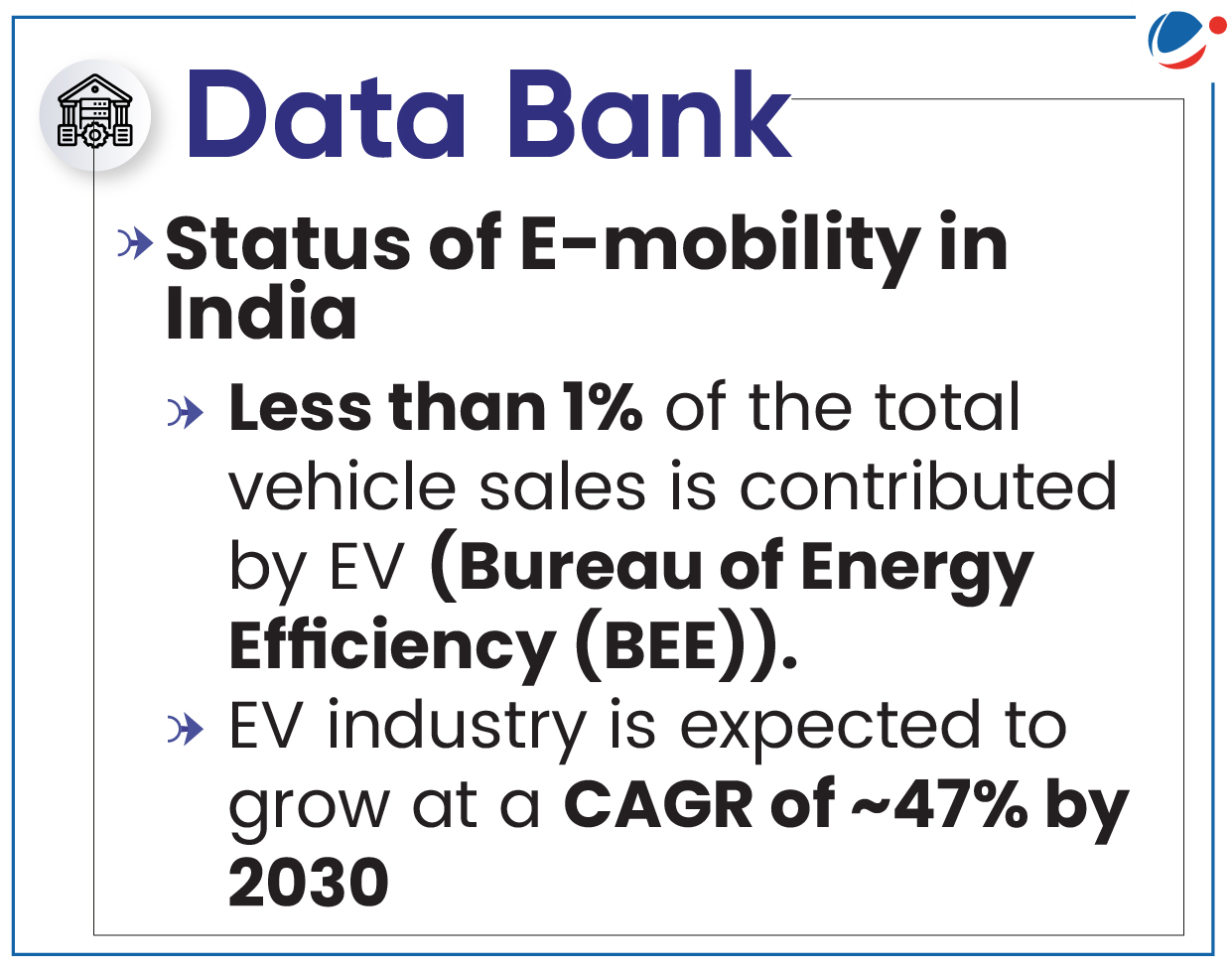Why in the News?
The "e-mobility R&D Roadmap for India" report has been released by the Principal Scientific Adviser to the Government of India to achieve net-zero targets.
More on the News
Report highlighted the technical areas and research projects that require immediate action over the next five years to become Atmanirbhar and emerge as a global leader in innovative mobility solutions.
Proposed R&D Roadmap | |
|---|---|
| Sphere | Measures Required |
| Energy Storage Cell | Accelerate the process of finding more Lithium reserves, implement globally available, established extraction technologies for lithium, utilize existing supply-chain strategies in Li-battery/ cell production etc. |
| EV Aggregates | Emphasis on Hybrid Energy Storage Systems (HESS), combining different energy storage technologies such as batteries and supercapacitors etc. |
| Material and Recycling | Economic analysis of recycling value-chain, implement methods for monitoring and reporting the environmental impact etc. |
| Charging and Refuelling | Proper road infrastructure for installation of a transmitting pad underneath the road, design scalable systems for dynamic wireless charging technology, design and development of adaptive charging techniques etc. |

Need/Requirement of the E-mobility in the Country
- Environment Sustainability: Transport sector contributes estimated 142 Million Tonnes of CO2 emissions annually, out of which 123 million tonnes is contributed by the road transport segment alone.
- Also, there will be reduction in emission of particulate matter and NOx (Nitrogen Oxides) emission which are a major cause of respiratory ailments.
- Alignment with global commitments such as Sustainable Development Goals (SDG's) and Panchamrit climate action plan, presented at COP26 (Glasgow) to the United Nations Framework Convention on Climate Change (UNFCCC).
- Reducing Import Dependence: Transport sector accounts for 18% of total energy consumption in India. This demand is being met mostly through imported crude oil.
- Transition to EVs will reduce the vulnerability to the volatile International crude oil prices.
- Export Potential: India is the world's third-largest Automobile market. This strength and capability can be channelized in the direction of Export of EVs.
- Other: Job creation (create 10 million direct jobs and 50 million indirect jobs), lower maintenance cost etc.
Challenges in transitioning to E-mobility
- Higher Cost: EVs tend to have a higher upfront cost compared to conventional Internal Combustion Engine (ICE) vehicles.
- Expensive batteries contribute to the higher initial cost of EVs.
- Charging Infrastructure: There are around 2000 charging stations in India. (NITI Aayog Report, 2021). The scarcity of charging stations lead to issues like range anxiety.
- Range anxiety is a term commonly used to explain the anxiety that EV owners or drivers may feel regarding the distance their vehicle may be able to cover with the charging, whether it be full or partial.
- Lack of Clean Energy: The transition to EV is not fully sustainable if the electricity used to charge them is generated from fossil fuels.
- Coal (including lignite) contributes about 50% of total electricity generation in India (Ministry of Power).
- Lack of Standardisation: Different manufacturers adopt varying battery chemistries, charging connectors, and powertrain configurations.
- E-Waste Management: About 90% of used batteries are either processed by unorganized industry or end up in landfills and garbage dumps.
- India ranks third in e-waste generation after China and the USA. (Global e-waste monitor, 2024)
- Complex/Vulnerable Supply Chain: E-mobility value chain heavily depend on imports of key elements such as cobalt, lithium, and nickel.
- Lithium resources are mainly concentrated in the Lithium Triangle (encompasses region of Argentina, Bolivia, and Chile)
Government initiatives for promotion of EV Manufacturing Ecosystem
- Electric Mobility Promotion Scheme 2024 (EMPS 2024): Launched by the Ministry of Heavy Industries (MHI).
- PLI Schemes: Production Linked Incentive (PLI) Scheme for Automobile and Auto Components Industry in India to boost domestic manufacturing of Advanced Automotive Technology products.
- PLI Scheme for manufacturing of Advanced Chemistry Cell (ACC) to bring down prices of battery in the country.
- Faster Adoption and Manufacturing of (Hybrid and) Electric Vehicles (FAME) India: Under FAME India Scheme Phase-II, Phased Manufacturing Programme (PMP) has been introduced.
- Rationalization of Goods and Services Tax (GST):
- on electric vehicles from 12% to 5%;
- on chargers/charging stations for electric vehicles from 18% to 5%.
- Promoting Charing Infrastructure: Ministry of Power has issued "Charging Infrastructure for Electric Vehicles – Guidelines and Standards".
- Ministry has also designated BEE as the Central Nodal Agency (CNA) for the National-level rollout of charging infrastructure in the country.
- States' Initiative: Karnataka, Telangana, Maharashtra and Uttar Pradesh have launched their respective state EV Policies.
- Other: National Electric Mobility Mission Plan (NEMMP) 2020, EV30@30 campaign (at least 30% of new vehicle sales to be electric by 2030), National Mission on Transformative Mobility and Storage etc.
- Formulating Battery Technology swapping Policy: Battery swapping involves switching out a depleted battery for a fully charged one at a swapping station within the battery swapping operator's (BSO) network.
Way Forward
The Standing Committee on Industry in its report on 'Promotion of Electric Vehicles in the Country' recommended following ways
- Standardisation: All stakeholder shall come together to adopt common standard in the sphere of charging port, etc. to ensure interoperability.
- Focus on Infrastructure:
- Setting up of charging stations should be incentivised for individual investors, women self-help groups and cooperative societies by offering an assured return.
- Setting up dedicated manufacturing hubs and industrial parks for manufacturing batteries, cells, and EV auto components.
- Finance Availability: EVs should be bought under the priority sector lending.
- Public Transport: Allocate more funds towards developing such public transport system which rely on e-buses.
- Vibrant Supply Chain Mechanism: Government should take initiatives to accelerate the extraction of lithium.



